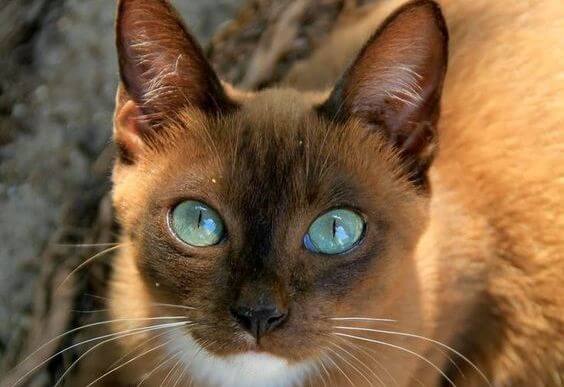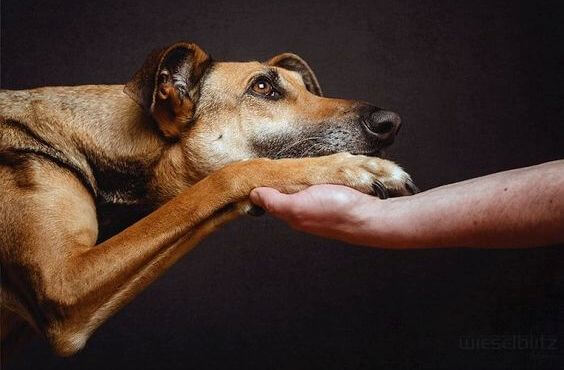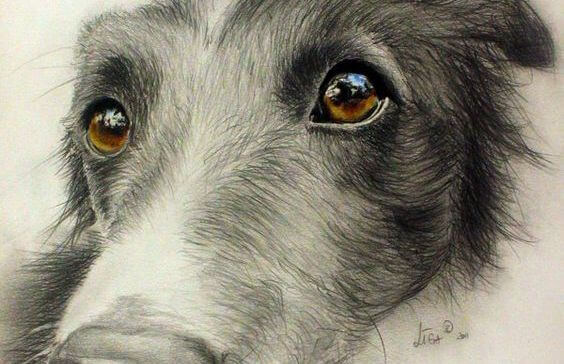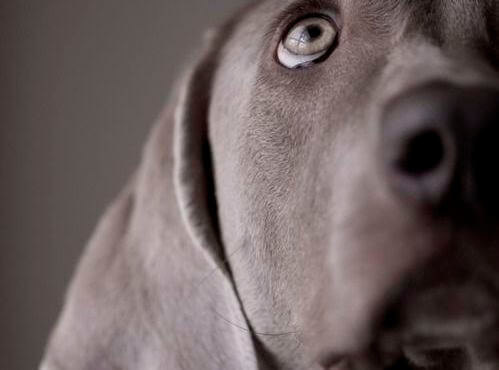An Animal’s Eyes Have the Power to Speak a Unique Language

When I look into the eyes of my dog, my cat, or any other animal, I do not see an “animal.” I see a living creature like myself, a friend, a soul that feels, that knows about affection and fear, and that deserves the same respect as any person.
The power of a glance goes far behind the sense of sight. As amazing as it may seem, our optical nerves are intimately connected to the hypothalamus, that delicate and primitive structure where our emotions and memory are located. He who looks feels, and this is something that animals, too, experience.
If the eyes are the window to the soul, something tells me that animals have one, too, because only they know how to speak with that language that does not need words: it is the language of affection and the most sincere respect.
We have all experienced the following at some point: going to adopt a dog or a cat and suddenly establishing a very intense connection with a certain one of them just by looking it in the eye. Without knowing how, they captivate and trap us. However, scientists tell us that there is something more profound and interesting than all of this.

Animals’ eyes, a very old connection
Two of the animals that have been used to living with humans for thousands of years are cats and dogs. Nobody is surprised anymore by the wise way they have of interacting with us. They look us straight in the eye and they are capable of expressing needs and desires through every kind of caress, gesture, movement of their tail, and various looks in the eye.
We have synthesized our behavior and language until we understand one another. It is much more the result of genetic evolution where some species have gotten used to living together to mutually benefit from one another. Something that also does not surprise is what was revealed to us by an interesting study conducted by anthropologist Evan MacLean: dogs and cats are quite capable of reading our emotions simply by looking us in the eyes.
Our pets are wise masters of feelings. They can identify basic gesture patterns to associate them with a given emotion, and they almost never fail at this. Nevertheless, this study explains something more to us: people tend to establish a connection with their cats and dogs that is very similar to the one we build with a small child.
We raise them, take care of them, and establish such a strong connection as if they were just another member of the family, something that, as amazing as it may seem, has been beneficial for our biological mechanisms after so many years of mutual interaction.

Our neural networks and our brain chemistry react in the same way as if we were taking care of a child or a person who needs our attention: we release oxytocin, the hormone of affection and care. At the same time, they also act in the same way: we are their social group, their herd, those complacent humans with which they can share the couch and the cat’s nine lives.
Biophilia, the connection to nature and animals
The world is much more beautiful when seen through the eyes of an animal. If all of us had the exceptional skill to connect with them in this way, “we would remember” aspects that used to be innate to us and that we have no forgotten due to the hustle and bustle of civilization.
Our societies are strongly tied to consumerism, to the overexploitation of resources, thereby injuring this planet Earth. We should pass this Earth to our grandchildren with the same beauty that we inherited, with its ecosystems intact, with its nature equally beautiful, vibrant, and glistening, and not with so many unfixable cracks.

When having a dog implied surviving better as a species
Edward Osborne Wilson is an American biologist and entomologist known for having coined the term “biophilia.” This word defines that love for everything living and that in general most of us who love animals experience. According to this scientist, the affinity hat we establish with our pets finds its origin in the early stages of our species’ evolution.
- When we look into an animals’ eyes, an emotional and genetic bond rises up within us without our being aware of it. Human beings established a very intimate kind of connection with certain kinds of animals, such as the dog, one of the most relevant in those faraway times when our top priority was survival.
- One of Edward Osborne’s theories is that those humans who within their social groups could count on the company of various dogs had better chances of staying alive as compared to those who still did not have this connection.
The people who were capable of getting an animal, domesticating it, and building a relationship of affection and mutual respect were much more strongly tied to nature, to its cycles, to those secrets with which they could find more resources that would help them keep moving forward in life: water, game, edible plants…

Maybe our dogs are no longer as useful today for obtaining food, but nevertheless, for many people, the closeness and companionship that they have with a dog or a cat is still absolutely necessary for “survival.”
They provide us with affection, with large doses of companionship, they relieve pain, they bring us joy, and they remind us each day why it is so comforting to look them in the eyes. They do not need words, because their language is much older, more basic, and even marvelously primitive: love.
Don’t stop enjoying their looks; look at your reflection in them each day and you will discover all the great things that lie within you.
When I look into the eyes of my dog, my cat, or any other animal, I do not see an “animal.” I see a living creature like myself, a friend, a soul that feels, that knows about affection and fear, and that deserves the same respect as any person.
The power of a glance goes far behind the sense of sight. As amazing as it may seem, our optical nerves are intimately connected to the hypothalamus, that delicate and primitive structure where our emotions and memory are located. He who looks feels, and this is something that animals, too, experience.
If the eyes are the window to the soul, something tells me that animals have one, too, because only they know how to speak with that language that does not need words: it is the language of affection and the most sincere respect.
We have all experienced the following at some point: going to adopt a dog or a cat and suddenly establishing a very intense connection with a certain one of them just by looking it in the eye. Without knowing how, they captivate and trap us. However, scientists tell us that there is something more profound and interesting than all of this.

Animals’ eyes, a very old connection
Two of the animals that have been used to living with humans for thousands of years are cats and dogs. Nobody is surprised anymore by the wise way they have of interacting with us. They look us straight in the eye and they are capable of expressing needs and desires through every kind of caress, gesture, movement of their tail, and various looks in the eye.
We have synthesized our behavior and language until we understand one another. It is much more the result of genetic evolution where some species have gotten used to living together to mutually benefit from one another. Something that also does not surprise is what was revealed to us by an interesting study conducted by anthropologist Evan MacLean: dogs and cats are quite capable of reading our emotions simply by looking us in the eyes.
Our pets are wise masters of feelings. They can identify basic gesture patterns to associate them with a given emotion, and they almost never fail at this. Nevertheless, this study explains something more to us: people tend to establish a connection with their cats and dogs that is very similar to the one we build with a small child.
We raise them, take care of them, and establish such a strong connection as if they were just another member of the family, something that, as amazing as it may seem, has been beneficial for our biological mechanisms after so many years of mutual interaction.

Our neural networks and our brain chemistry react in the same way as if we were taking care of a child or a person who needs our attention: we release oxytocin, the hormone of affection and care. At the same time, they also act in the same way: we are their social group, their herd, those complacent humans with which they can share the couch and the cat’s nine lives.
Biophilia, the connection to nature and animals
The world is much more beautiful when seen through the eyes of an animal. If all of us had the exceptional skill to connect with them in this way, “we would remember” aspects that used to be innate to us and that we have no forgotten due to the hustle and bustle of civilization.
Our societies are strongly tied to consumerism, to the overexploitation of resources, thereby injuring this planet Earth. We should pass this Earth to our grandchildren with the same beauty that we inherited, with its ecosystems intact, with its nature equally beautiful, vibrant, and glistening, and not with so many unfixable cracks.

When having a dog implied surviving better as a species
Edward Osborne Wilson is an American biologist and entomologist known for having coined the term “biophilia.” This word defines that love for everything living and that in general most of us who love animals experience. According to this scientist, the affinity hat we establish with our pets finds its origin in the early stages of our species’ evolution.
- When we look into an animals’ eyes, an emotional and genetic bond rises up within us without our being aware of it. Human beings established a very intimate kind of connection with certain kinds of animals, such as the dog, one of the most relevant in those faraway times when our top priority was survival.
- One of Edward Osborne’s theories is that those humans who within their social groups could count on the company of various dogs had better chances of staying alive as compared to those who still did not have this connection.
The people who were capable of getting an animal, domesticating it, and building a relationship of affection and mutual respect were much more strongly tied to nature, to its cycles, to those secrets with which they could find more resources that would help them keep moving forward in life: water, game, edible plants…

Maybe our dogs are no longer as useful today for obtaining food, but nevertheless, for many people, the closeness and companionship that they have with a dog or a cat is still absolutely necessary for “survival.”
They provide us with affection, with large doses of companionship, they relieve pain, they bring us joy, and they remind us each day why it is so comforting to look them in the eyes. They do not need words, because their language is much older, more basic, and even marvelously primitive: love.
Don’t stop enjoying their looks; look at your reflection in them each day and you will discover all the great things that lie within you.
This text is provided for informational purposes only and does not replace consultation with a professional. If in doubt, consult your specialist.







